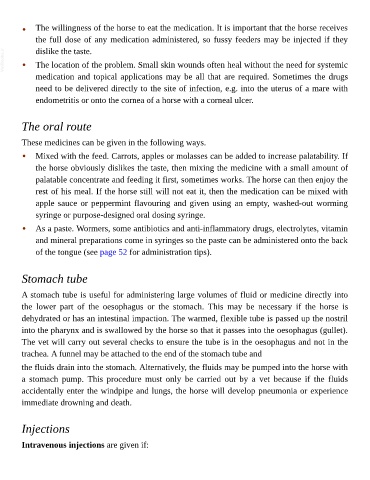Page 1094 - The Veterinary Care of the Horse
P. 1094
• The willingness of the horse to eat the medication. It is important that the horse receives
the full dose of any medication administered, so fussy feeders may be injected if they
VetBooks.ir • dislike the taste.
The location of the problem. Small skin wounds often heal without the need for systemic
medication and topical applications may be all that are required. Sometimes the drugs
need to be delivered directly to the site of infection, e.g. into the uterus of a mare with
endometritis or onto the cornea of a horse with a corneal ulcer.
The oral route
These medicines can be given in the following ways.
• Mixed with the feed. Carrots, apples or molasses can be added to increase palatability. If
the horse obviously dislikes the taste, then mixing the medicine with a small amount of
palatable concentrate and feeding it first, sometimes works. The horse can then enjoy the
rest of his meal. If the horse still will not eat it, then the medication can be mixed with
apple sauce or peppermint flavouring and given using an empty, washed-out worming
syringe or purpose-designed oral dosing syringe.
• As a paste. Wormers, some antibiotics and anti-inflammatory drugs, electrolytes, vitamin
and mineral preparations come in syringes so the paste can be administered onto the back
of the tongue (see page 52 for administration tips).
Stomach tube
A stomach tube is useful for administering large volumes of fluid or medicine directly into
the lower part of the oesophagus or the stomach. This may be necessary if the horse is
dehydrated or has an intestinal impaction. The warmed, flexible tube is passed up the nostril
into the pharynx and is swallowed by the horse so that it passes into the oesophagus (gullet).
The vet will carry out several checks to ensure the tube is in the oesophagus and not in the
trachea. A funnel may be attached to the end of the stomach tube and
the fluids drain into the stomach. Alternatively, the fluids may be pumped into the horse with
a stomach pump. This procedure must only be carried out by a vet because if the fluids
accidentally enter the windpipe and lungs, the horse will develop pneumonia or experience
immediate drowning and death.
Injections
Intravenous injections are given if:

